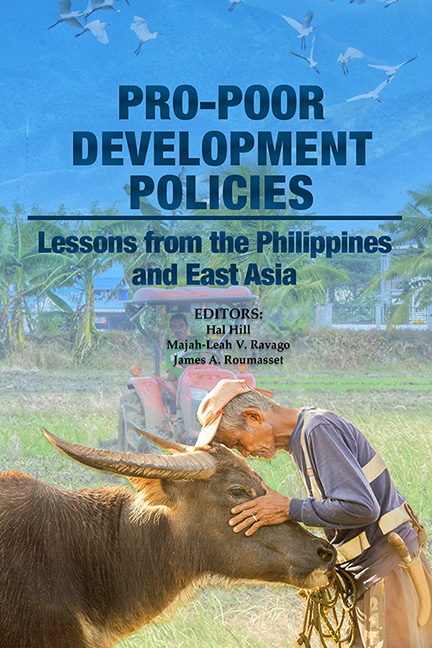Book contents
- Frontmatter
- Dedication
- Contents
- Figures, Tables and Boxes
- Foreword
- Foreword
- Message
- Preface and Acknowledgements
- About the Editors
- About the Contributors
- Acronyms
- Part 1 Introduction and Synthesis
- Part 2 Agricultural and Economic Development
- Part 3 Economic Policies for Achieving Targeted Levels of Living in the Philippines
- Part 4 Inequality and Economic Development
- Part 5 Competition Law and Policy
- Part 6 International Dimensions
- Index
21 - Regulation, Market Evolution and Competition in the Philippine Microfinance Sector
Published online by Cambridge University Press: 09 January 2024
- Frontmatter
- Dedication
- Contents
- Figures, Tables and Boxes
- Foreword
- Foreword
- Message
- Preface and Acknowledgements
- About the Editors
- About the Contributors
- Acronyms
- Part 1 Introduction and Synthesis
- Part 2 Agricultural and Economic Development
- Part 3 Economic Policies for Achieving Targeted Levels of Living in the Philippines
- Part 4 Inequality and Economic Development
- Part 5 Competition Law and Policy
- Part 6 International Dimensions
- Index
Summary
INTRODUCTION
The Philippine microfinance sector encompasses banks, non‑governmental organizations (NGOs) and various non-bank financial intermediaries (e.g., cooperatives and credit unions) providing financial services to customers that most mainstream financial institutions deem too costly or risky. The sector has transformed over the years, both in terms of the number of institutions providing microfinance services and the number of clients served. From the late 1980s when NGOs and similar not-for-profit institutions used to dominate microlending, the sector has steadily grown, attracting commercial players, chiefly banks of varying orientations (e.g., rural, thrift and cooperative banks), encouraged by the business potential of tapping a large, hitherto underserved, market. The microfinance clientele has similarly grown from a few thousands to several millions (MCPI 2016).
The growth of the sector can be traced in part to a wider acceptance of the view that broadening access to finance is an effective strategy for poverty alleviation. The pessimism that grew out of the failed subsidized credit programmes of an earlier period has given way to a more sanguine view of “banking with the poor”, based on the celebrated successes of models like the Grameen Bank and the Association for Social Advancement (ASA) of Bangladesh and BancoSol of Bolivia. A key element in these successful experiments has been the application of sound banking principles emphasizing financial sustainability, challenging microfinance institutions (MFIs) to rely less on government or donor subsidies while serving more of the poor.
At the institutional level, the creation of a policy environment more hospitable to financial inclusion supported the paradigm shift from one of subsidy dependence to financial sustainability. This included the adoption of microfinance standards for NGOs as well as the encouragement given banks to get involved in microfinance. In 1997, the Philippines rolled out the National Strategy for Microfinance (NSM) to provide the framework for the promotion of microfinance as a sustainable activity. The strategy called for government policies directed at enlarging the role of private MFIs in financial services provision for low-income groups. It also provided the basis for subsequent laws and issuances on financing poverty alleviation measures.
- Type
- Chapter
- Information
- Pro-poor Development PoliciesLessons from the Philippines and East Asia, pp. 595 - 632Publisher: ISEAS–Yusof Ishak InstitutePrint publication year: 2022

